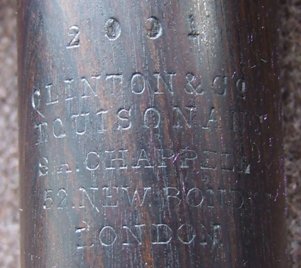Chappell's Clinton
Equisonant
Introduction
Samuel Arthur Chappell was a maker and dealer in
woodwinds and brass, flourishing in London from 1862 to 1901.
During the 1880's, he advertised as "mfr. of the patent Siccama and
Clinton flutes, Savary model bassoons, etc". Although Chappell
Siccama flutes are common enough, up til now we had not seen an example
of his Clinton model, except perhaps for the enigmatically labelled "A
form of Clinton's flute" in the Royal College of Music Collection.
So we were much excited when Phil Wells, of Suffolk England, brought
this very clear example to our attention.

Chappell Clinton Equisonant-model flute, No 2001
The Mark
|
The top of the body bears the most extensive
mark:
2001
Clinton & Co
Equisonant
S A Chappell
52 New Bond St
London
Parts of this
information are repeated elsewhere on the flute, with
Clinton & Co
Patentee
added at the top
of the head. |
 |
Provenance
The earliest traced owner was George Leaton (b.
Millwall, London 1884 to George Leaton and Charlotte Chinn).
The younger George is shown (right) with his wife Florence
Morris on their wedding day in 1912
Given the dates of the 52 New Bond St workshops
(1871-1901), it seems likely that George must have bought the
flute second hand or inherited it.
Phil Wells reports that George played the flute
at the local (Wimbledon) Gilbert and Sullivan society.
George worked for British Railways and designed the complex
interlocking lever mechanisms between points and signals in the
signal boxes (which meant he was not called up in the 1914-1918
war). Perhaps the flute mechanism had a special appeal! The current owner is Sam Wells, flute player, of
Suffolk, UK (great grandson of George)
|
 |
Characteristic features

-
The flute is cylindrical
(i.e. uses Boehm's bore). This puts it late among Clinton's
developments - he first demonstrated a cylindrical model at the 1862
Exhibition, took off a prize, patented his developments and then
died 2 years later.
-
It features the graduated
holes that were the subject of Clinton's patent and prize. Note
that the foot key cups are greatly larger than those of the left hand
keys.
-
It features a standalone G#
key, the short F, and the classic mark of Clinton, the combined C and Bb
key for the left thumb (not visible in this image). As usual, the
C and Bb combination are also available to R1 (via the trill style key
in the middle of the image)
-
A duplicate G# key is linked to
the key over the A hole to provide the A with full venting. This seems
to have been an option in Clinton's day.
Unusual features
-
The Boehm style foot was not
Clinton's common early arrangement, but he used it on the
cylindrical wooden flutes that most
resemble this one. It certainly makes sense from Chappell's point of
view some years later.
-
Probably the most intriguing feature
is the pair of small key touches available to R1. These no doubt provide F
sharp and F natural. The small bar running between the tops of the touches
presumably closes the F# key when the F touch is pressed.
This may be just a variation on a detail of Clinton's 1863 patent, wherein he
positioned a crescent-shaped F-natural key to the left of his usual R1 F# key.
The Chappell pair looks more visually similar to Carte's 1867 arrangement, which
may well be derived from the Clinton 1863 idea anyway.
More work to be done on this flute if we are to understand
what was Clinton's and what was Chappell's. We'll add to this
record as time and opportunity permits.
|